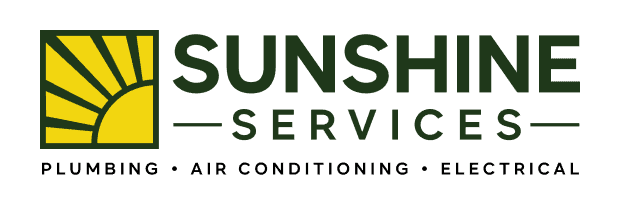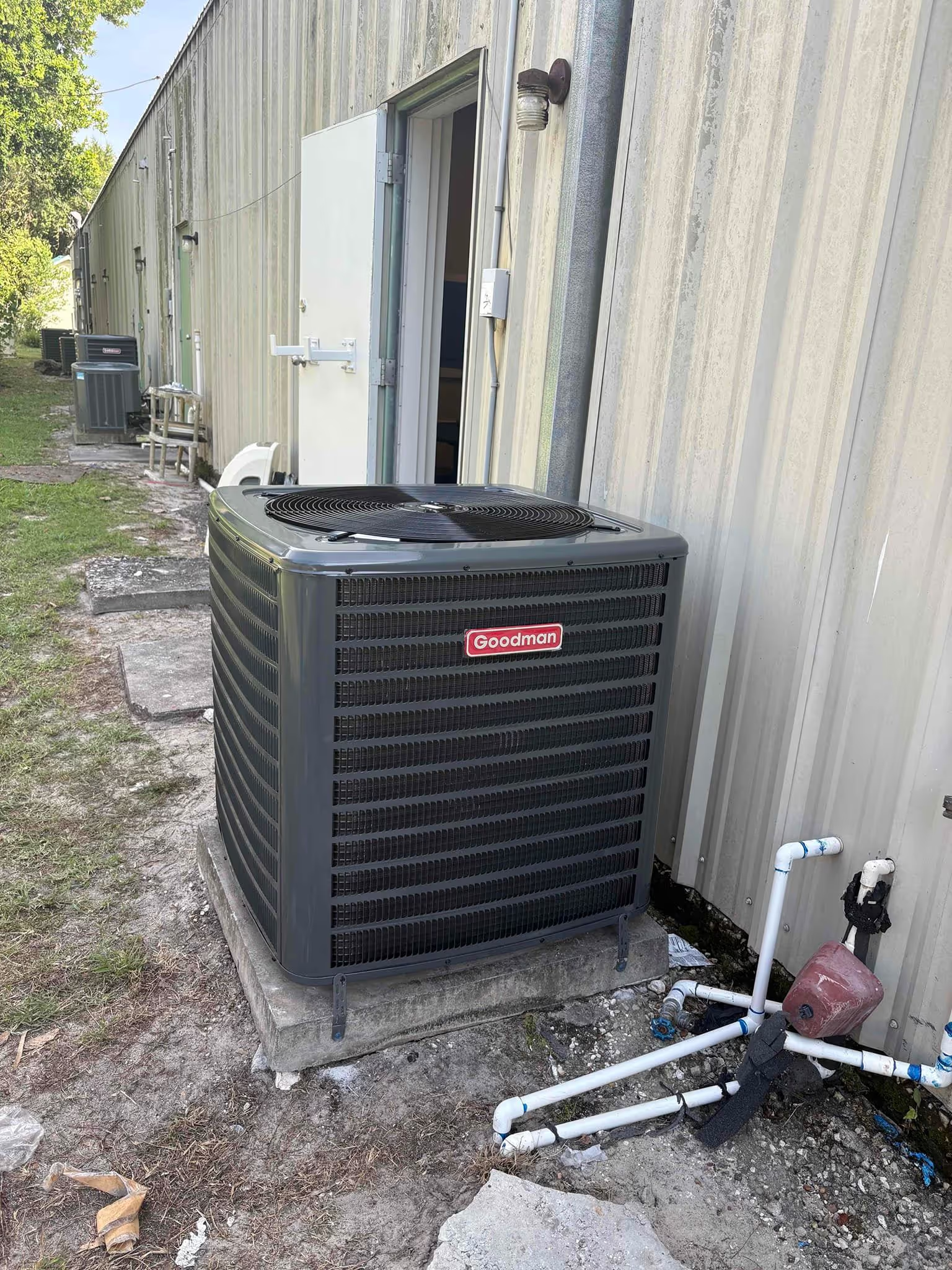


FREE Water Heater
With every whole house repipe purchase. Free brand-new water heater or credit towards a tankless water heater.
.svg)
.svg)
.svg)
.svg)



With every whole house repipe purchase. Free brand-new water heater or credit towards a tankless water heater.
.svg)
.svg)
.svg)
.svg)

When a commercial air conditioning system breaks down, businesses face more than just uncomfortable temperatures. A broken AC can significantly impact business operations by affecting employee productivity, customer comfort, and even equipment performance. Smart business owners recognize that quick repair response and proper maintenance prevent costly downtime.
Commercial AC systems work harder than residential units and face unique challenges. These systems cool larger spaces, run longer hours, and handle more stress throughout the year. Understanding common problems and repair costs helps business owners make informed decisions about maintenance and replacements.
Florida businesses especially need reliable cooling systems that can handle intense heat and humidity while keeping operational costs under control.
In this article, you’ll learn how commercial AC repair helps Florida businesses maintain comfort, control costs, and avoid downtime.
Let’s break down the key points you should consider.
Keep reading! The key to successful commercial AC management involves recognizing warning signs early, working with qualified technicians, and planning maintenance schedules around business needs.
Commercial buildings need working air conditioning to keep operations running smoothly. Regular maintenance prevents sudden breakdowns that disrupt business and keeps everyone comfortable year-round.
According to the U.S. Energy Information Administration (EIA), cooling systems account for approximately 14% of total electricity use in commercial buildings across the United States. This highlights the financial importance of keeping systems well-maintained and energy-efficient.
A well-maintained AC system runs more reliably than one that gets ignored. Regular maintenance catches small problems before they turn into major breakdowns that shut down the system completely.
When temperatures stay steady, employees work better. They focus on their tasks instead of feeling too hot or cold. Studies show that office workers are most productive when temperatures stay between 68-72 degrees.
Customers notice when a building feels uncomfortable. A restaurant with broken AC loses diners on hot days. Retail stores see fewer shoppers when the air feels stuffy or too warm.
Key benefits of steady operation:
AC systems work harder during peak seasons. Summer heat and winter cold put extra stress on equipment. Regular checkups help systems run at peak efficiency when businesses need them most.
Clean filters and coils use less energy to cool the same space. A dirty system can use 20-30% more electricity than a clean one. This adds hundreds or thousands of dollars to monthly bills.
Technicians also check refrigerant levels and electrical connections during maintenance visits. Low refrigerant makes the system work harder. The U.S. Department of Energy notes that effective commercial HVAC maintenance can lead to energy savings between 5% and 20% annually, depending on system condition and usage. Loose connections waste energy and create fire risks.
Energy savings from maintenance:
Minor AC problems get worse over time if nobody addresses them. A small refrigerant leak becomes a major system failure. Worn belts snap completely and damage other parts.
Common small fixes include:
These repairs typically cost $100-500 each. Waiting too long can lead to compressor replacement, which costs $3,000-8,000 for commercial units.
Regular inspections find problems early when they cost less to fix. Most commercial AC systems last 15-20 years with proper care. Without maintenance, they often fail after 8-12 years.
Business owners who schedule quarterly maintenance spend less on AC repair for business needs over time. They also avoid the costs of emergency service calls and lost productivity from system downtime.
Professional technicians use proven diagnostic methods to quickly identify commercial AC problems. They focus on airflow patterns, electrical components, and refrigerant systems to pinpoint issues before they cause major downtime.
Technicians start by measuring airflow at supply vents using digital anemometers. They check for readings below 200 CFM per ton of cooling capacity, which signals restricted airflow.
Common airflow diagnostic steps:
Hot spots often indicate blocked vents or failed dampers. Techs use infrared thermometers to map temperature differences across the building. Differences greater than 5°F between zones suggest balance issues.
Dirty filters cause 70% of airflow problems. Technicians check pressure drops across filters first. They also inspect blower wheels for debris buildup that reduces air movement.
Belt-driven systems need tension checks. Loose belts slip and reduce airflow by up to 30%. Techs use belt tension gauges to ensure proper tightness.
Temperature sensors fail frequently in commercial systems. Technicians test sensor resistance with multimeters to verify accurate readings. Faulty sensors send wrong signals to control boards.
Key electrical diagnostic points:
Control boards show error codes when components fail. Experienced techs read these codes first to narrow down problems quickly. They also check for loose connections that cause intermittent faults.
Thermostat issues cause 40% of service calls. Technicians verify thermostat settings match actual room temperatures. They test heating and cooling cycles to confirm proper operation.
Power supply problems affect sensitive electronics. Techs measure voltage at the control panel to ensure stable 24V and 120V readings. Voltage fluctuations damage control boards over time.
Dirty evaporator coils reduce cooling capacity by 30%. Technicians use flashlights to inspect coil fins for dirt buildup and blockages. They check for ice formation that indicates refrigerant problems.
Clogged drain lines cause water damage and high humidity. Techs test drains by pouring water into drain pans. They use wet/dry vacuums to clear blockages from drain lines.
Refrigerant system diagnostics:
Low refrigerant levels reduce cooling and damage compressors. Technicians measure pressures with manifold gauges and compare readings to manufacturer specifications. They calculate superheat and subcooling values to determine refrigerant charge accuracy.
Refrigerant leaks often occur at pipe joints and coil connections. Electronic leak detectors help techs find small leaks that cause gradual refrigerant loss. Large leaks create obvious pressure drops and warm air from vents.
Commercial AC repair costs vary widely based on system complexity and the type of problem. The $5000 rule helps business owners decide when repairs make financial sense versus replacing equipment entirely.
Commercial HVAC repairs typically cost between $300 and $3,500 for common issues. Simple problems like thermostat replacements run $150 to $400.
More complex repairs cost significantly more. Compressor replacements range from $1,500 to $3,000. Evaporator coil repairs cost $800 to $2,200.
Common commercial AC repair costs:
System size affects repair costs dramatically. A 20-ton commercial unit costs more to repair than a 5-ton system. Parts are larger and require specialized labor.
Emergency repairs cost 50% to 100% more than regular service calls. Weekend and holiday repairs carry premium pricing.
The $5000 rule helps determine when replacing equipment makes more sense than repairing it. Business owners multiply the system's age by the repair cost estimate.
If the total exceeds $5000, replacement often proves more cost-effective long-term. This calculation considers both current repair needs and future reliability issues.
Example calculations:
The rule works because older systems need more frequent repairs. Energy efficiency also declines with age, increasing operating costs.
Some repairs justify exceptions to this rule. Minor fixes on newer systems make sense even if the calculation exceeds $5000.
Commercial HVAC technicians charge $75 to $150 per hour for standard repairs. Rates vary based on location, experience level, and service complexity.
Metropolitan areas command higher rates than rural locations. Certified technicians with specialized training charge premium rates.
Factors affecting hourly rates:
Emergency service calls include minimum charges of 2-4 hours regardless of actual time spent. This covers travel time and equipment costs.
Some companies charge flat rates for specific repairs instead of hourly billing. This approach provides predictable costs for common problems like thermostat replacements or filter changes.
Smart scheduling cuts equipment failures by 40% and saves over 15 hours weekly for commercial facilities. Proper planning includes emergency services, prevention strategies, and detailed records that protect investments.
Emergency breakdowns don't wait for business hours. Quality repair companies offer 24/7 service to handle urgent issues when systems fail during nights, weekends, or holidays.
Staged repair approaches help minimize disruption during business hours. Technicians can:
Temporary cooling solutions keep businesses running during major repairs. Portable units maintain comfortable temperatures while permanent systems undergo extensive work.
Response time commitments vary by service level:
Smart contractors coordinate with facility managers to plan repairs around business schedules. This reduces lost productivity and keeps customers comfortable.
Regular maintenance prevents 85% of commercial AC breakdowns before they happen. Scheduled inspections catch small problems before they become expensive emergencies.
Key preventive tasks include:
AI-powered scheduling systems track equipment history and predict when components need attention. These tools analyze usage patterns and environmental factors to optimize maintenance timing.
Peak season preparation starts months early. Spring tune-ups ensure systems handle summer heat loads without failing during the hottest days.
Maintenance frequency depends on usage:
Preventive contracts typically cost 60% less than reactive repairs. They also extend equipment life by 3-5 years through proper care.
Detailed service records protect warranty coverage and help plan future expenses. Digital documentation systems track every repair, part replacement, and maintenance visit.
Essential documentation includes:
This information supports warranty claims when manufacturers require proof of proper maintenance. Missing records often void coverage and cost thousands in denied claims.
Budget planning becomes more accurate with historical data. Facilities can predict when major components need replacement and set aside appropriate funds.
Digital systems offer advantages:
Smart scheduling platforms generate reports showing maintenance costs, energy savings, and system performance trends. This data helps justify investments in newer, more efficient equipment.
Florida businesses need reliable commercial HVAC services that handle the state's unique climate challenges. The right contractor combines proper licensing, fast response times, and professional coordination to keep operations running smoothly.
Licensed contractors provide the foundation for quality commercial HVAC services. Florida requires specific certifications for commercial work that differ from residential licenses.
Check these credentials before hiring:
Response time matters when cooling systems fail. Many Florida commercial ac services offer emergency repair within 24 hours. Some companies provide same-day service for urgent situations.
Ask potential contractors about their typical response times. Get specific timeframes rather than vague promises.
Parts availability affects repair speed significantly. Companies with local inventory can fix problems faster than those ordering parts from distant suppliers.
Quality contractors stock common commercial parts or have reliable supplier relationships. This reduces downtime when systems need repairs.
Safety protocols protect both workers and building occupants during repairs. Commercial HVAC work often involves rooftop equipment and electrical systems.
Experienced contractors follow OSHA guidelines and use proper safety equipment. They also coordinate with building management to ensure work doesn't disrupt business operations.
Rooftop access requires careful planning for commercial properties. Contractors need proper equipment to reach rooftop units safely.
Professional companies handle access logistics without involving property managers in complex arrangements. They bring their own lifts, ladders, and safety gear as needed.
Tenant coordination keeps businesses running during repairs. Good contractors work around business hours when possible.
They communicate repair schedules clearly and minimize disruptions. This includes controlling noise levels and limiting access restrictions during peak business times.
Quick assessment starts the repair process efficiently. Professional technicians can diagnose most commercial AC problems within the first hour of arrival.
They use diagnostic tools to identify issues accurately rather than guessing. This prevents unnecessary repairs and reduces total costs.
Clear quotes eliminate surprise charges later. Reputable Florida commercial ac services provide written estimates before starting work.
The quote should include:
Efficient restoration gets businesses back to normal operations quickly. Experienced commercial teams work systematically to restore cooling without cutting corners.
They test systems thoroughly before leaving to prevent callback visits. This ensures repairs last and cooling stays consistent.
Commercial AC repair keeps businesses running smoothly. A working air conditioning system creates a comfortable space for workers and customers.
Regular maintenance prevents small problems from becoming big ones. Quick repairs save money compared to replacing entire systems.
Business owners should watch for warning signs like:
Professional repair services offer several key benefits:
Benefit
Impact
Energy savings
Lower monthly bills
Better air quality
Healthier workplace
Fewer breakdowns
Less business disruption
Longer system life
Delayed replacement costs
Companies need reliable HVAC professionals they can trust. Experienced technicians can fix problems quickly and correctly.
Preventive care works better than waiting for breakdowns. Regular check-ups catch issues early and keep systems running well.
Smart business owners make AC maintenance a priority. They understand that comfort affects both worker productivity and customer satisfaction.
The right repair company makes all the difference. They respond fast when problems happen and help prevent future issues.
Commercial AC systems work hard every day. Taking good care of them protects the business investment and keeps everyone comfortable.
Schedule your commercial AC repair or maintenance visit today to minimize downtime and keep your business comfortable year-round.